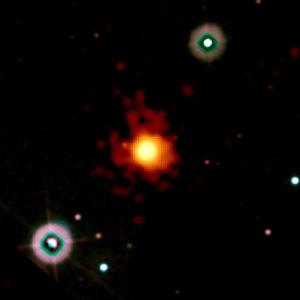Post
Beyond the
Farthest Star
11 April 2013
When you look up into the night sky, you are seeing into the past. Cosmic distances are so vast that it takes time for light to travel them. Light from the closest star to Earth—the Sun—takes more than 8 minutes to reach us. After several hours that same light reaches the outer region of our solar system, where Pluto and other dwarf planets reside, but it will take more than four years for the light to reach the next nearest star. After 100 years the light from our sun has reached less than 20,000 stars. The brightest star in the night sky is Sirius, more than 8 light-years away, which means we see Sirius not as it is now, but as it was 8 years ago.
Most of the stars we see are even further away. The constellation Orion has several bright stars. Betelgeuse, the red star at the upper shoulder of Orion, is about 640 light-years away. Rigel, the bright blue star at Orion’s foot, is about 800 light-years away. Even further away is the Orion Nebula, more than 1,300 light years away. When you look at that fuzzy patch in Orion’s sword, the light that strikes your eyes began its journey when the Roman Empire was reaching its end, Islam was just beginning, and the Tang Dynasty was at its height.
The farthest object we can see with the naked eye is a faint object in the constellation Andromeda. On a clear dark night it looks almost like a smudge of chalk dust against the night sky. This faint smudge is the Andromeda Galaxy, the nearest spiral galaxy to our own Milky Way Galaxy, and is 2.5 million light-years away. To look at Andromeda is to look back to a time when early human ancestors, such as Homo habilis were walking the plains of Africa.
With modern telescopes we can see much further than the Andromeda Galaxy. In recent years astronomers have observed stars and galaxies billions of light years away. Just a few years ago the farthest object ever observed was neither a galaxy nor a star, but rather a gamma ray burst (GRB). A gamma ray is a kind of light with an extremely short wavelength. Visible light, such as the color green, has a wavelength of about 500 nanometers, which is the length of 5,000 hydrogen atoms placed end to end, or about the size of a virus. A gamma ray is about a picometer in length. A single hydrogen atom is about 60 picometers wide. Because of their short wavelengths, gamma rays have a very high energy. A gamma ray burst is a short, intense blast of gamma rays produced by the death of a star as it goes supernova, or by the collision of two neutron stars. They last only from a few seconds to several minutes, but they are incredibly bright. It is thought that Betelgeuse will produce a gamma ray burst when it becomes a supernova sometime in the next few thousand years. (We don’t need to worry, though, since the burst won’t be directed toward Earth. We will only see the supernova as a star which becomes brighter than the moon for a while.)
 NASA/Swift/Stefan Immler
NASA/Swift/Stefan ImmlerIn 2009 astronomers were able to observe a gamma ray burst named GRB 090423, seen here. When they measured its distance they found the light from GRB 090423 had been traveling for about 13 billion years. The universe is only about 13.5 to 14 billion years old, so this burst occurred between the time when atoms had formed—about 400,000 years after the big bang—and the time when stars and galaxies start forming—about 900 million years after the big bang—which is a period known as the Cosmic Dark Ages. By studying the light from GRB 090423, astronomers found that it was caused by the death of an early star. They were also able to show that this star was not a first generation star. In other words it was not a star formed from the hydrogen and helium created by the big bang, it was formed by the gas and dust remains of earlier stars which had exploded, just as our sun was formed from older, long dead stars. This means some stars must have lived and died even before this star formed more than 13 billion years ago, which is much earlier than once thought possible.
Since then we’ve observed a few slightly more distant objects. These seem to be protogalaxies, but determining their exact distance is a bit of a challenge. We will likely find even more distant objects when the James Webb telescope is launched.
So the next time you are out at night, take a trip back in time and look up at the stars.